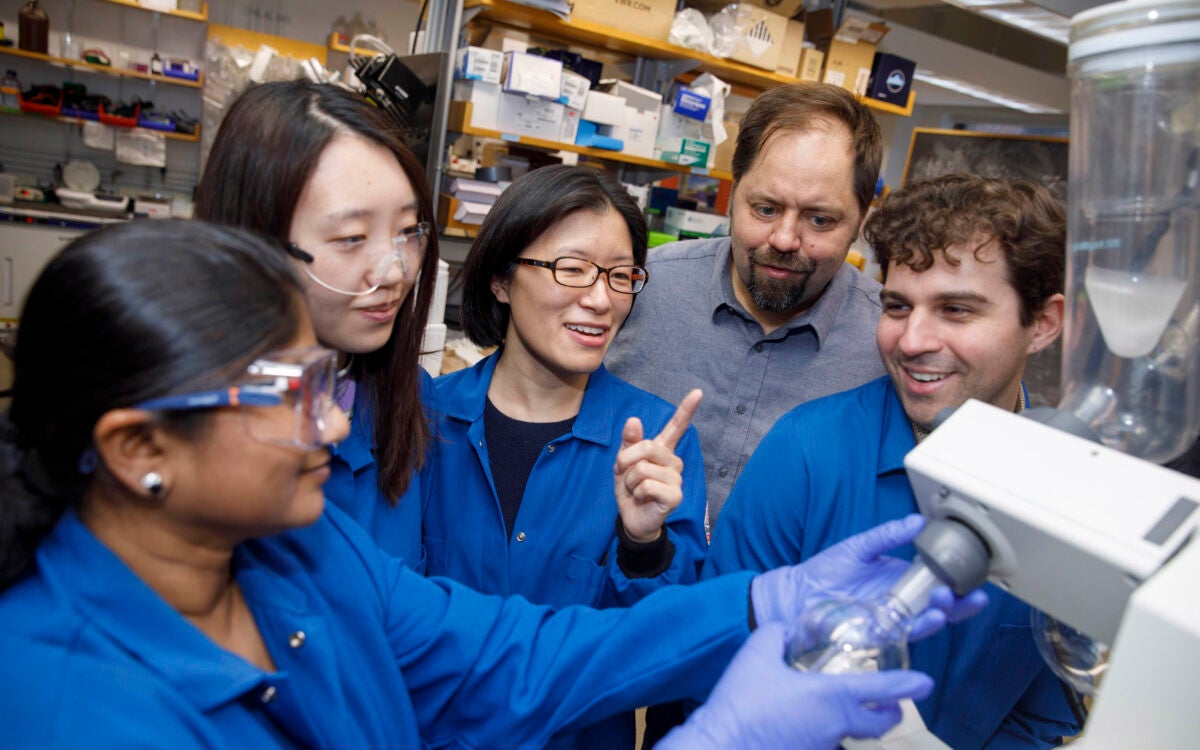Viruses get the silent treatment, any disease is a target
What do you do if you’re sure you’ve found a way to knock out the AIDS virus but you can’t get the medicine into infected cells? That was the problem faced by Judy Lieberman, a professor of pediatrics at Harvard Medical School.
Using tiny bits of genetic material, she and her research team have blocked messages sent from genes that underlie diseases like genital herpes and hepatitis. “We used the technique to protect mice against liver failure,” she says. “Eighty percent of the protected animals lived; 80 percent of those without the protection died.”
Such protection is provided by small molecules of RNA (ribonucleic acid), which interfere with messages sent from genes instructing various proteins to be made. Interference RNA (RNAi) “tears up” these messages. For example, if a gene in the liver sends a signal that would lead to destruction of a liver cell, RNAi can block the signal. The RNAi itself is not destroyed in the process and survives to silence additional unwanted messages.
Because all genes work through signals they send to other parts of a cell, RNAi might be used to silence an incredible variety of diseases, including AIDS, type 1 diabetes, rheumatoid arthritis, blinding macular degeneration, cancers, and, possibly, Asian bird flu. Studies already are under way to use RNAi to block human genes involved in AIDS, hepatitis, muscle-wasting Lou Gerhrig’s disease, macular degeneration, and breast cancer.
In principle, Lieberman says, “virtually any disease could be targeted by new classes of drugs based on RNAi.”
During the 2007 annual meeting of the American Association for the Advancement of Science in San Francisco (Feb. 15-19), Lieberman will describe how she beat long odds to develop a new process that can get RNAi molecules into specific cells. For example, it might be used to direct RNAi drugs into cells infected by HIV, the virus that causes AIDS. The process, licensed to a company in Cambridge, Mass., called Alnylam Pharmaceuticals, should help all researchers now working on these types of drugs.
Going deep
One researcher, Craig Mello of the University of Massachusetts Medical School, shared the 2006 Nobel Prize in medicine for discovering the silencing powers of RNAi. He has formed a company in Worcester, Mass., called RXi, to develop a better drug for Lou Gehrig’s disease (amyotrophic lateral sclerosis, or ALS).
Fascinated by the potential of RNAi, Lieberman began working on it at the CBR Institute for Biomedical Research at Harvard Medical School. Here, she found a way to prevent the spread of genital herpes with an RNAi drug applied to the surface of the genital tract of mice. The technique provides protection that lasts for weeks.
“From this result, we got the idea that humans might be able to use a topical drug like this as protection that would last more than one night,” Lieberman recalls. “It would not be a vaccine, but it might be effective for a couple of weeks.”
Lieberman, who is also director of the Division of AIDS at Harvard Medical School, then began to investigate if RNAi drugs can be used to suppress HIV infections. Working with collaborators at the CBR Institute and the nearby Massachusetts Institute of Technology, the team managed to knock down such infections in a test tube. Now she wants to determine if RNAi can be used to prevent sexual transmission or to treat ongoing infections of HIV. The National Institutes of Health recently granted her $7.8 million to try.
Her first idea was to test an RNAi drug that could be applied to the surface of genital tracts, rather than being injected. “It’s a real hurdle, but we are making progress,” Lieberman notes. However, it would be better to get these small molecules into the infected cells deep in the body, So she and her team have developed a method to do this that could be used on people who are already infected. It would get RNAi into the interior of the body where white blood cells carry the virus. This is the process she will describe to her colleagues on Feb. 18 at the American Association for the Advancement of Science meeting.
Going wide
As Lieberman is quick to admit, it’s a long way and time from the lab to the shelf of a pharmacy. But if RNAi drugs can make the trip, what she has created should also be useful for treating cancers of the blood and lymph system like leukemia and lymphoma, as well as for breast cancer. For each disease, specific RNAi “bullets” must be customized to target specific cells involved in the malady.
“These would not be vaccines,” Lieberman notes. “Rather they would require a course of treatment over months.”
Mello’s group is working on the bullet for Lou Gehrig’s disease. At least three other labs have begun human testing of RNAi drugs for treating macular degeneration, the leading cause of blindness in older people. These tests are for safety, to answer the question of whether people can recover their eyesight without toxic side effects. “So far, it looks like a go,” Lieberman says.
RNAi also looks like a possible way to fight autoimmune diseases, such as type 1 diabetes, rheumatoid arthritis, and lupus. These are ailments caused by the body’s own cells attacking healthy tissues and organs.
These drugs may also provide one answer to stopping the threat of Asian bird flu if it starts being spread by humans. It’s something Lieberman’s lab is interested in working on, she says.
Lots of promising drugs are crowded into the pipeline to success, but that’s a trip that often is measured in decades. The hope is that RNAi drug development will go faster than the norm, because of rapid advances in decoding the human genome. Once the chemical sequence of a disease gene is known, it could take only months, not years, to develop an RNAi silencer for its message, Lieberman speculates.
“Alnylam Pharmaceuticals did a human safety test on an RNAi drug for a respiratory virus, which attacks newborns, in only 15 months,” she notes. “That’s really unheard of in drug development.”
On the one hand, Lieberman says, “RNAi technology can, in principle, target virtually any disease. On the other, we have to be cautious because it’s still early. Problems no one can anticipate could occur. But the whole thing is amazing – very exciting.”




